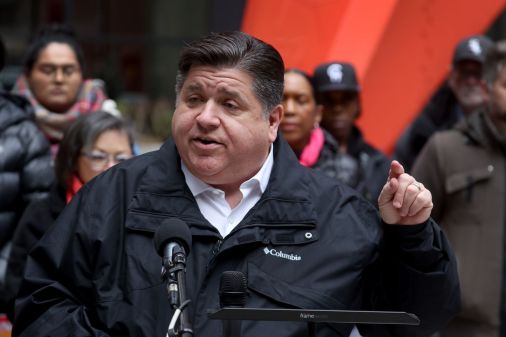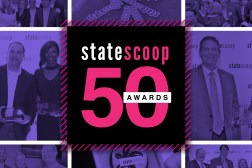Meet the StateScoop 50 GoldenGov Nominees: Illinois CIO Hardik Bhatt

For Illinois and Chief Information Officer Hardik Bhatt, 2015 was a year of transition.
While planning and implementing the state’s new enterprise resource planning software, Bhatt teamed with Gov. Bruce Rauner to create the Department of Innovation and Technology. The new department brought the state’s IT operation to the governor’s Cabinet and centralized the Illinois’ tech operations.
Now going forward, Bhatt has embarked on a journey to establish a “Smart State” — taking a page from the smart cities trend underway in metropolitan areas.
For his efforts to drive Illinois forward with IT modernization and centralization, Bhatt was nominated for a StateScoop 50 GoldenGov award, which highlights the visionary leaders setting the standard for the future of information technology.
StateScoop talked with Bhatt about the transition into a new IT department and his reflections on public service.
Editor’s note: This interview was edited for clarity and conciseness.
StateScoop: Tell us about some of your main achievements over the past year that may have resulted in your nomination for a GoldenGov award?
Hardik Bhatt: Over the past year, we worked to turn IT from a back-office commodity service provider to a critical catalyst for Illinois’ Digital Transformation, by moving from under a shared services organization to a Cabinet-level position. Our overall transformation stands on four pillars:
- Operational transformation through the first statewide implementation of an enterprise resource planning product and enterprise performance management.
- For the ERP, we’ve finished the design and blueprint for a unified financial system. The first set of agencies are ready to go live in fall 2016.
- On Enterprise Performance Management, we’re holding regular enterprise IT performance management sessions to review IT’s performance based on defined key performance indicators.
- Customer-service transformation by building key capabilities
- In our data analytics practice, we’ve established an enterprise-level data analytics system with an initial focus on health care and human services and interoperability.
- We’re making mobile the premier platform internally and externally. So far, we have a mobile app for child care caseworkers in its proof of concept mode. We also have a mobile portal for the Illinois Students Assistance Commission and an online database of all professional licenses available online.
- In addition, we’re applying design research methodologies for improving the end-to-end customer experience through the creation of a one-stop design process for business customers. Through this practice, we’ve streamlined our foster care program.
- Organizational transformation via consolidation of distributed agency IT functions
- We’ve consolidated all of our previously siloed IT departments under the executive branch into the newly formed Department of Innovation Technology. In the new department, we have 1,700 employees and a $1 billion IT budget. Illinois has a central IT department for the first time in the state’s history — and we accomplished it within 10 months.
- The new organization will be built on vertical business clusters (like health and human services, public safety) and horizontal skills with technology-based teams. The new centralized procurement authority for IT will enable economies of scale across the enterprise.
- Cultural transformation by establishing collaborative communities with key deliverables
- We’ve established 11 working groups and developed a statewide IT strategy, which is now live in video format. We’ve also created a CIO council of more than 60 agency CIOs who meet regularly as change agents and collaborate on important deliverables, get updated on key initiatives, engage in speaker sessions with CEOs and participate in a CIO leadership development program.
- In addition, we’re engaging in new partnerships with the state’s entrepreneurial community and universities.
- For the ERP, we’ve finished the design and blueprint for a unified financial system. The first set of agencies are ready to go live in fall 2016.
- On Enterprise Performance Management, we’re holding regular enterprise IT performance management sessions to review IT’s performance based on defined key performance indicators.
- In our data analytics practice, we’ve established an enterprise-level data analytics system with an initial focus on health care and human services and interoperability.
- We’re making mobile the premier platform internally and externally. So far, we have a mobile app for child care caseworkers in its proof of concept mode. We also have a mobile portal for the Illinois Students Assistance Commission and an online database of all professional licenses available online.
- In addition, we’re applying design research methodologies for improving the end-to-end customer experience through the creation of a one-stop design process for business customers. Through this practice, we’ve streamlined our foster care program.
- We’ve consolidated all of our previously siloed IT departments under the executive branch into the newly formed Department of Innovation Technology. In the new department, we have 1,700 employees and a $1 billion IT budget. Illinois has a central IT department for the first time in the state’s history — and we accomplished it within 10 months.
- The new organization will be built on vertical business clusters (like health and human services, public safety) and horizontal skills with technology-based teams. The new centralized procurement authority for IT will enable economies of scale across the enterprise.
- We’ve established 11 working groups and developed a statewide IT strategy, which is now live in video format. We’ve also created a CIO council of more than 60 agency CIOs who meet regularly as change agents and collaborate on important deliverables, get updated on key initiatives, engage in speaker sessions with CEOs and participate in a CIO leadership development program.
- In addition, we’re engaging in new partnerships with the state’s entrepreneurial community and universities.
We’re also now accelerating these items by focusing on becoming the nation’s first “Smart State.”
SS: What are you most proud of accomplishing during your time in your role? What’s still left to be done?
HB: Moving IT from a shared service and perceived commodity to a Cabinet-level position means that my team and our technology are recognized as a strategic business asset. We accomplished this by focusing on ROI for the customer, using agile management techniques such as 75-day sprints, delivering on what we promised — like the ERP financial design and moving to mobile — and directly addressing cultural issues through change management techniques like establishing collaborative communities. IT can either be at the table or on the menu. We are now at the table.
Looking forward, we still need to work on getting the state’s first ERP system ready to be rolled out in a few months. We’re also looking to hire a chief data officer and some other key talent. In addition, we’re improving the use of the state’s fiber assets and the data center while continuing to build our innovation capabilities
SS: What’s been the biggest challenge you guys have faced in the past year? How’d you overcome it?
HB: Illinois is still awaiting its fiscal year 2016 budget. Most of the work being done internally and by vendors extending their services in anticipation of getting paid when the budget passes. In fact, all of the accomplishments above were achieved without a budget. We can accelerate modernization and transformation even more when there is a budget. We also work within a tough union environment with 94 percent of our IT workforce unionized, which does not provide a lot of flexibility.
SS: Why public service? What lessons would you like to share with the next generation of state and local IT leaders?
HB: Public service is an incredible opportunity to serve your community and have a deep impact and lasting satisfaction. Working in public service creates a well-rounded executive that understands and has relationships with the entire community.
So far, I’ve learned that international and business experience in government is very valuable. Leaders need to externalize the enterprise: bring in outside experts like we have via mechanisms such as strategic advisory boards, entrepreneur showcases and the CEO speakers series.
SS: What advice do you have for next year’s eventual class of GoldenGov nominees?
HB: Practice servant leadership. Do what is best for the taxpayer.
This Q&A is part of a StateScoop series highlighting the nominees for the StateScoop 50 GoldenGov award. Winners of the StateScoop 50 awards will be announced on May 4.






